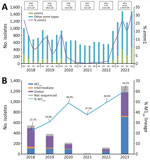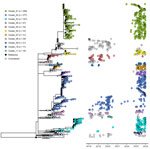Disclaimer: Early release articles are not considered as final versions. Any changes will be reflected in the online version in the month the article is officially released.
Alyssa R. GoldenAuthor affiliation: Public Health Agency of Canada, Winnipeg, Manitoba, Canada (A. Golden, A. Griffith, I. Martin); Provincial Laboratory for Public Health (Microbiology), Edmonton, Alberta, Canada (G.J. Tyrrell); Public Health Ontario, Toronto, Ontario, Canada (J.V. Kus); University of Toronto, Toronto (J.V. Kus); Mount Sinai Hospital, Toronto (A. McGeer); Institut National de Santé Publique du Québec, Sainte-Anne-de-Bellevue, Québec, Canada (M-.C. Domingo); British Columbia Centre for Disease Control, Vancouver, British Columbia, Canada (J. Grant); Roy Romanow Provincial Laboratory, Regina, Saskatchewan, Canada (J. Minion); Cadham Provincial Laboratory, Winnipeg (P. Van Caeseele); Laboratoire de Santé Publique du New Brunswick, Moncton, New Brunswick, Canada (G. Desnoyers); Queen Elizabeth II Health Science Centre, Halifax, Nova Scotia, Canada (D. Haldane); Newfoundland and Labrador Public Health Laboratory, St. John’s, Newfoundland, Canada (Y. Yu); Queen Elizabeth Hospital, Charlottetown, Prince Edward Island, Canada (X. Ding); Stanton Territorial Hospital Laboratory, Yellowknife, Northwest Territories, Canada (L. Steven); Yukon Communicable Disease Control, Whitehorse, Yukon, Canada (J. McFadzen); Public Health Agency of Canada, Ottawa, Ontario, Canada (C. Primeau)
The hypervirulent M1UK lineage of group A Streptococcus (GAS), originally identified in the United Kingdom in 2019, has been associated with increased notifications of scarlet fever and invasive GAS (iGAS) infections (1). The M1UK lineage is characterized by increased production of speA (streptococcal pyrogenic exotoxin A) and is differentiated from the M1global lineage by 27 key single-nucleotide variants (SNVs) (1). Initial characterization of a subset of emm1 isolates collected in Canada during 2016–2019 identified 10% of isolates as the M1UK lineage (2).
Beginning in 2022, several health organizations, including the World Health Organization and the Pan American Health Organization, reported increased cases of pediatric iGAS in numerous member countries, above seasonal expectations (3,4). Many countries in Europe, including Belgium, Netherlands, and the United Kingdom (5–7), have associated increased iGAS disease in the 2022–23 season with emm1, particularly the M1UK variant. In light of the worldwide increased iGAS disease activity and the association of those increases with emm1, we sought to describe the trends in emm1 and M1UK in Canada during 2018–2023.
We identified 2,582 isolates of iGAS emm1 collected during 2018–2023 as part of the passive, laboratory-based surveillance system for iGAS in Canada (8). Of those, we sequenced 2,315 isolates by using Illumina NextSeq technology (https://www.illumina.com); the remainder were received as line-listed typing data only. We identified M1UK isolates by mapping whole-genome sequencing reads to reference strain MGAS5005 and identifying 27 characteristic SNVs, as previously described (1). We performed core SNV phylogenetic analysis by using the SNVPhyl pipeline (9) and identified genomic clusters by using ClusterPicker with default settings (10). We assessed presence of antimicrobial resistance, toxin, and virulence genes by using the WADE pipeline (https://github.com/phac-nml/wade), the public virulence factor database (http://www.mgc.ac.cn/VFs), and custom database queries. The M1UK genomic data reported in our study have been deposited in the National Center for Biotechnology Information Sequence Read Archive (BioProject PRJNA1137869).
We assessed trends in lineage distribution for statistical significance by using the Cochran-Armitage test for trend and differences between lineages by using the 2-tailed Fisher exact test (α = 0.05). We aggregated data regionally into the Western (British Columbia, Alberta), Prairie (Saskatchewan, Manitoba), Central (Ontario, Québec), Eastern (New Brunswick, Nova Scotia, Prince Edward Island, Newfoundland and Labrador), and Northern (Yukon, Northwest Territories, Nunavut) regions of Canada.
Figure 1

Figure 1. Expansion of invasive group A Streptococcus emm1 and the M1UK lineage in Canada, 2018–2023. A) Number of emm1 isolates collected, by quarter....
In 2018, emm1 accounted for 17.1% of iGAS isolates collected in Canada, after which the proportion of emm1 decreased significantly, to a low of 0.5% in 2021 (p<0.0001), followed by a sharp increase to 24.5% in 2023 (p<0.0001) (Figure 1, panel A). Overall, during 2018–2023, a total of 46.2% of the 2,315 sequenced emm1 isolates were the M1UK lineage. The proportion of M1UK isolates increased from 22.1% (110/497) in 2018 to 60.2% (711/1,182) in 2023 (p<0.0001) (Figure 1, panel B). In 2023, the proportion of M1UK was highest in the Prairie region (66.7%), followed by the Central (62.5%), Western (58.9%) and Eastern regions (35.3%); no M1UK was collected in the Northern region. The only common (n>20) emm1 subtype associated exclusively with the M1UK lineage was emm1.147; subtypes emm1.146 and emm1.25 were exclusively associated with the M1global genotype. Subtypes emm1.0 and emm1.3 were associated with both M1global and M1UK genotypes (40.8% of emm1.0 and 95.0% of emm1.3 were M1UK).
Few antimicrobial resistance determinants were identified within the M1global or M1UK cohorts (Table). Compared with other emm1 isolates, the M1UK variant demonstrated significantly higher presence of genes speC (streptococcal pyrogenic exotoxin C) and ssa (streptococcal superantigen), as well as virulence factors spd1 (phage-associated DNase) and hylP (phage-associated hyaluronidase).
Phylogenetic analysis of all emm1 isolates identified clear separation of the M1global and M1UK lineages (Appendix Figure 1); the isolates within the M1UK cluster differed from those in the M1global cluster by an average of 46 (range 22–80) SNVs. Within the M1UK cluster, isolates differed by an average of 17.6 (range 0–41) SNVs, and there was more variability within isolates of the M1global lineage (average 32.6 [range 0–82] SNVs difference).
Figure 2

Figure 2. Maximum-likelihood core single-nucleotide variant phylogeny for 1,069 invasive group A Streptococcus M1UK lineage isolates collected in Canada, 2018–2023. Eleven large clusters are shown, each containing 10–280 isolates....
ClusterPicker identified 11 large clusters within the M1UK cohort, each cluster containing 10–280 isolates (Figure 2; Appendix Table). In general, the highest proportion of each cluster was collected in 2023, which is consistent with the surge of iGAS disease cases that year. Exceptions include clusters 4 and 11, which included isolates predominantly collected before the emm1 decrease that coincided with the COVID-19 pandemic. Clusters 1, 5–7, and 10 were identified exclusively after the COVID-19 pandemic period, and clusters 2 and 8 persisted across the study period. Clusters were generally associated with geographic region: clusters 1, 2, 5, 7, and 10 were strongly associated with the Central region, and clusters 3, 6, 8, and 9 were strongly associated with associated with the Western region. Cluster 4 was mostly found in the Eastern region; Cluster 11 was predominantly from the Prairie region. Within the Central region, approximately two thirds of the total isolates collected during the study period were part of either cluster 1 or cluster 2. Cluster 3 was most common for isolates collected from the Western (40.7%) and Prairie (25.0%) regions, and cluster 4 was most common in the Eastern region (53.8%).
More than 99% of isolates within M1UK cluster 1 possessed speC, ssa, spd,1, and hylP (Appendix Table). Within cluster 3, a total of 78.5% of isolates possessed speC and spd1; presence of ssa and hylP was sporadic. Those 4 genes were sporadically present within clusters 2 and 7.
Our study highlights expansion of the M1UK GAS lineage in Canada. Initial genomic characterization of emm1 isolates in Canada identified only 10% M1UK in a subset of emm1 isolates collected during 2016–2019 (2); by 2023, M1UK comprised 60.2% of emm1 isolates. The proportion of M1UK in Canada in 2023 is much higher than that most recently published from the United States (11%), although considerably lower than that reported by recent studies from Belgium (78%) and the United Kingdom (95.7%) (5,7,11). Our study findings are consistent with findings of Vieira et al., who noted that the M1UK lineage showed less genomic diversity than the M1global lineage (7). Of note, we did not identify any isolates of the novel M1DK lineage, which was originally identified in Denmark and was responsible for 30% of iGAS cases in Denmark in winter 2022–23 (12).
Our study identified a large proportion of M1UK isolates with the bacteriophage-encoded DNase spd1 and speC/ssa superantigens. The presence of those 3 genes suggests acquisition of a virulent prophage related to ΦHKU488.vir, which has been associated with outbreaks of emm12 scarlet fever in Asia (13,14). However, the lack of antimicrobial resistance determinants in Canadian emm1 isolates so far indicates limited transfer of the integrative conjugative elements that have been responsible for macrolide, lincosamide, and tetracycline resistance in GAS outbreaks in Asia (14). Although M1UK with this phage were present in Canada before the COVID-19 pandemic, their presence substantially expanded in 2023, particularly in central Canada (Figure 2, cluster 1). M1UK isolates within cluster 3 were associated with speC and spd1 only; that combination is associated with a different prophage, ΦSP370.1 (15). Those isolates were more common in western Canada beginning in 2023, suggesting a different path of virulence gene acquisition compared with that of ΦHKU488.vir. Monitoring the spread of the variants of M1UK, particularly for development of antimicrobial resistance, will remain critical. Our study underscores the value of linking laboratory data to epidemiologic variables to enhance our knowledge of how GAS variants affect clinical manifestations, outcomes, and risk groups.
Dr. Golden is a biologist in the Streptococcus and Sexually Transmitted Infections Section at the National Microbiology Laboratory, Public Health Agency of Canada. She focuses on surveillance, antimicrobial resistance, and genomic epidemiology of invasive streptococcal diseases.
留言 (0)